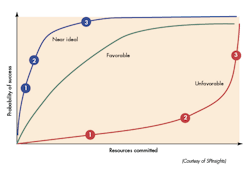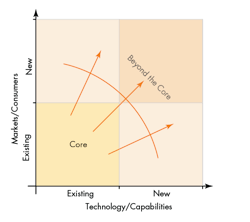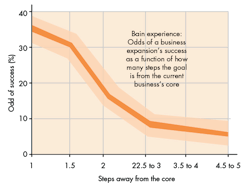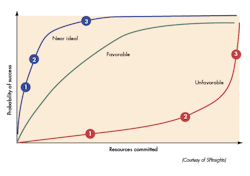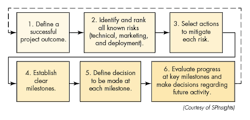Managing Risks When Innovating Beyond the Core
In a 2012 paper titled “Innovation Adventures Beyond the Core,” David Edwards looks at some of the lessons to be learned from Avery Dennison’s experiences in innovating beyond its core markets. To clarify what he meant by “beyond the core,” he referred to a graph (Fig. 1) and explained, “As you start to move out and seek to acquire new customers and markets or develop new technologies, or in some cases do both, it’s much more challenging. You have no domain knowledge; you’re playing in spaces that you don’t really understand. Very often you’re talking to customers who don’t even know who you are.”
One aspect of managing the risk on any far-reaching innovation program not addressed by Edwards was the harm that can come from rigidly adhering to a Stage Gate process most probably designed for more incremental improvements. That risk is nicely illustrated by an anecdote shared by one of my GEN3 Partners colleagues. He tells a story about a client company whose Stage Gate process required that a market study be completed before technical analysis of an exciting new idea could be funded. The logic made sense: Why spend valuable R&D funds before there was evidence the technology would satisfy a tangible market need? In this instance, however, the cost of the marketing study was estimated at $300K, while the cost of the technical analysis was estimated at $30K. The marketing department refused to spend that kind of money until they were assured the idea was technically feasible. Company managers, firmly adhering to their Stage Gate process, would not authorize the technical study without a solid marketing basis. No one was willing to bend the rules, so the innovation died.
A recommendation born from this dilemma is that companies adopt a customized Stage Gate process anytime they consider innovations beyond the core where the odds of success are inherently low. Although the major Stage milestones should probably remain in place, the sequence of events should be adjusted within each Stage. We advocate that this adjusted sequence of tasks should be based on doing whatever reduces the most risk per dollar spent at each step along an innovation pathway. Figure 3 illustrates this concept. The red path is certainly the least desirable strategy because it lets a great deal of time and money be spent during the early and intermediate stages of a project while delaying major risks until the end. In contrast, the blue path attacks the biggest risk factors early, regardless of whether they are technical, marketing, supply chain, or deployment uncertainties. Thus, if the project runs into an insurmountable roadblock, it can be terminated early with minimal loss of time or money—the notion of “failing fast” if you’re going to fail.
A method for determining the general sequence of task identification and sequencing is illustrated in Fig. 4. Note that it is repetitive in nature, offering the opportunity to constantly reorder the tasks within a given Stage based on progress made and lessons learned.
Douglas Hoon is the founder and president of ComGraf LLC, an ongoing design and development firm focused on sporting goods and consumer products. Since 2008, Mr. Hoon has also been a member of the leadership team for GEN3 Partners, an early-stage product, process and packaging innovation firm, headquartered in Boston and serving an international clientele of Fortune 1000 companies.
About the Author
Douglas Hoon
Founder and President
Douglas Hoon is a member of several small start-ups focused on sporting goods, advanced packaging concepts for portion-controlled foods and beverages, various consumer products, and safer guns. He previously spent almost 35 years in engineering fields related to precision optics and advanced composites manufacturing and innovation consulting. Hoon earned an M.S. in Mechanical Engineering from MIT and a B.S. in general engineering from the U.S. Military Academy. For more information, see his profile on LinkedIn.com.
